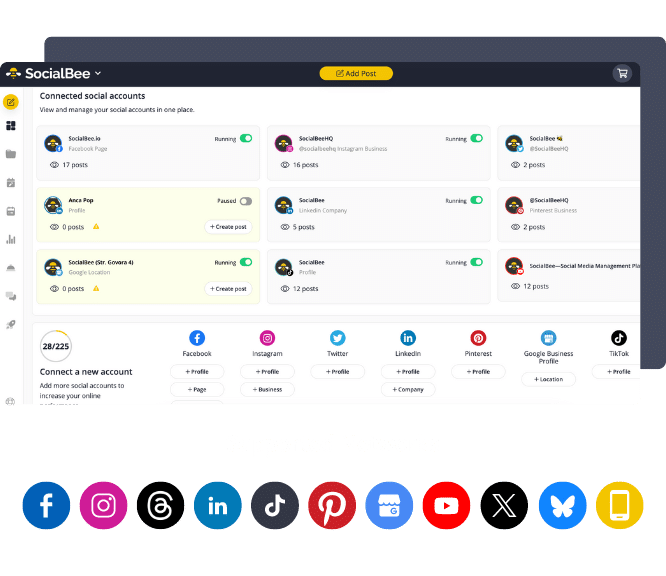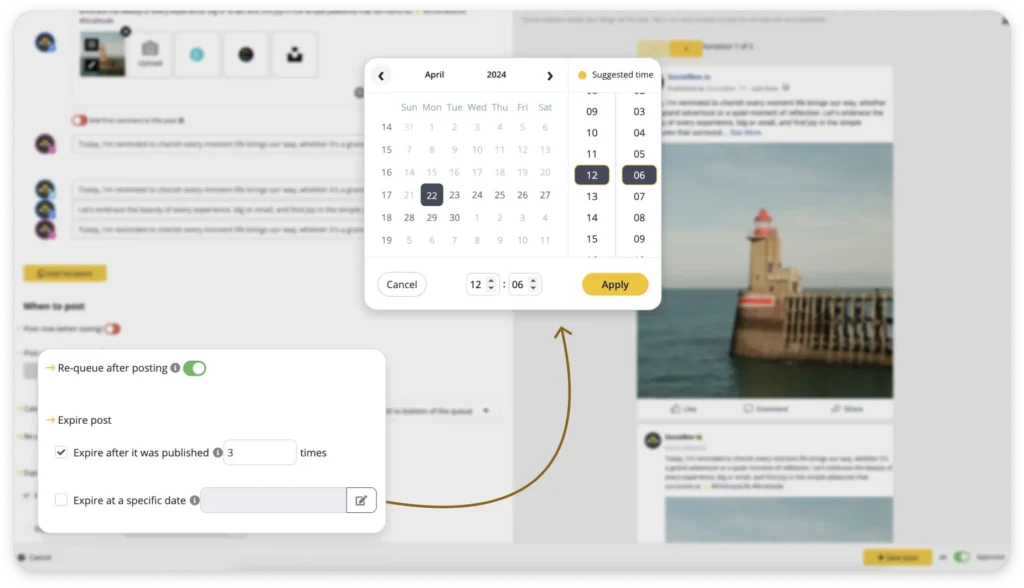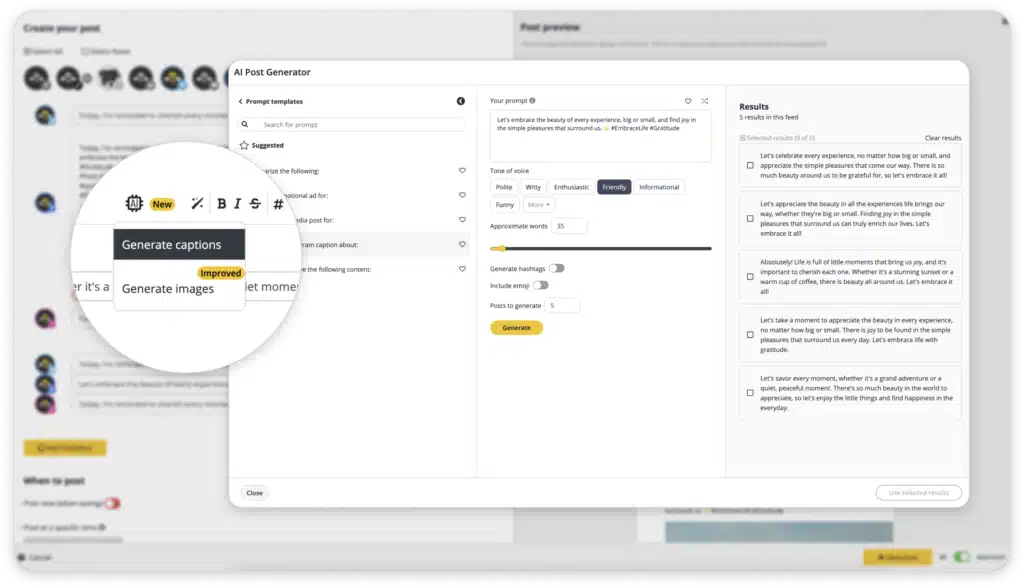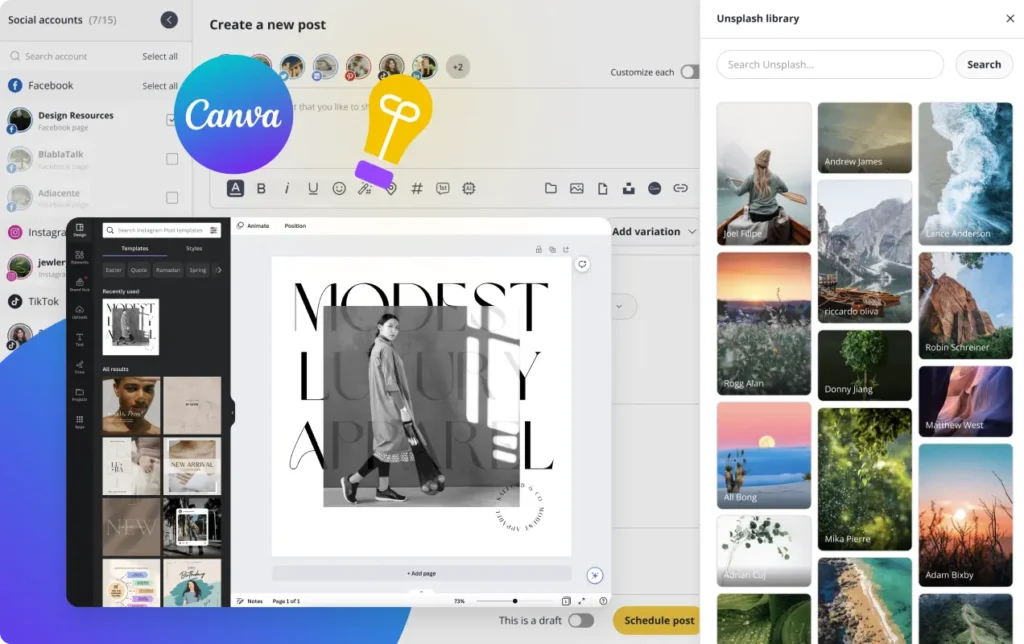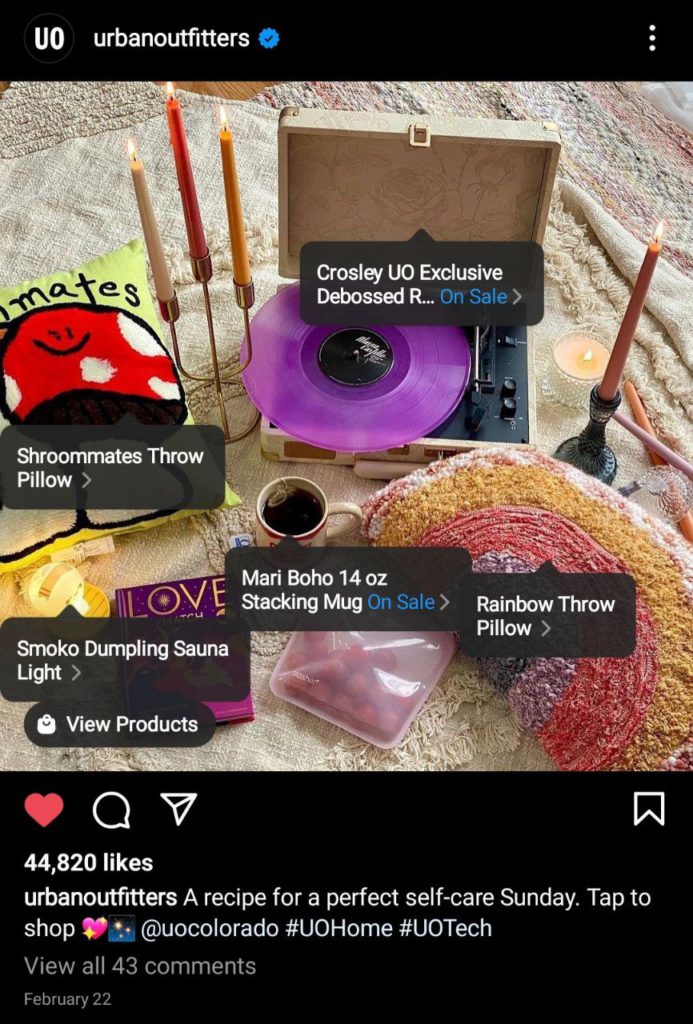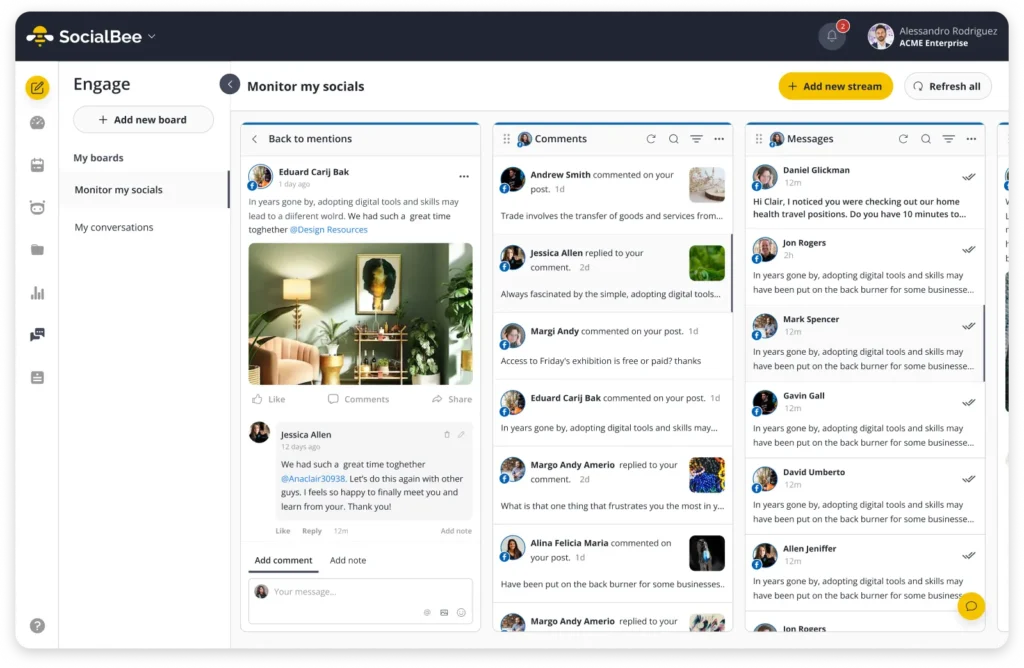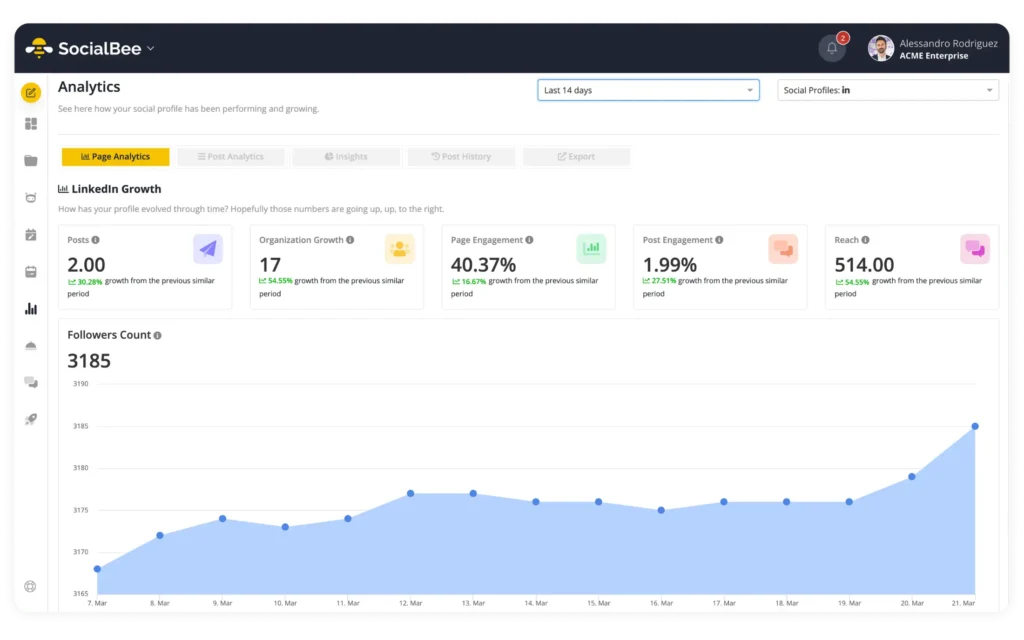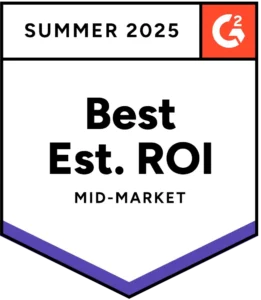
Content Writer at SocialBee
What’s the best way to approach social media management for small businesses? As the line between digital and offline interactions continues to blur, small businesses find themselves navigating the world of social media to connect with their audience, promote their brand, and drive sales.
This article aims to guide small business owners through the intricacies of efficient social media management, offering practical tips, strategies, and insights to help you effectively engage with your audience and achieve your marketing goals.
From understanding audience behavior to crafting compelling content and analyzing your performance, we’ll explore the pillars of effective social media management that can transform your small business’s online presence. Let’s begin!
We’re SocialBee LABS SRL, part of WebPros. We use the information you provide to share relevant content and product updates, as outlined in our Privacy Policy. You can opt out anytime.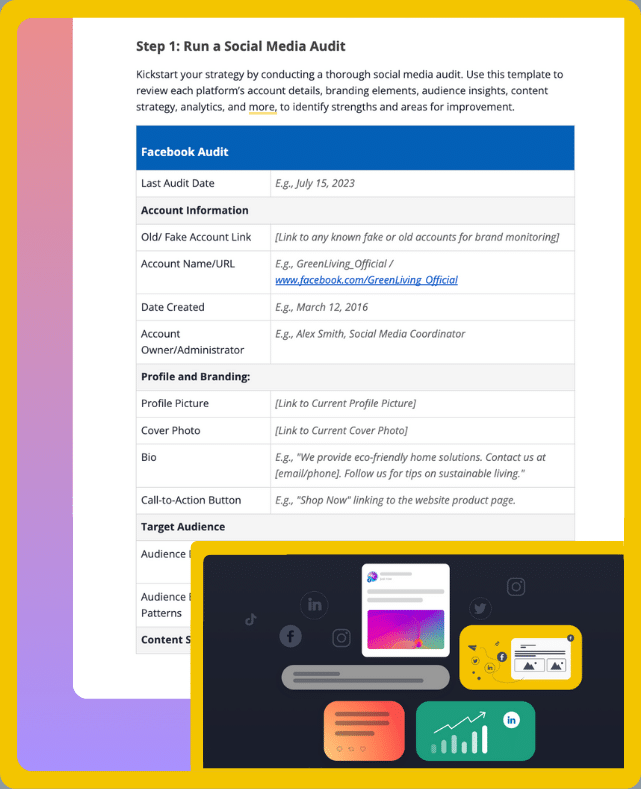
Short summary
- Balancing social media management with other business operations is a must, with research indicating that dedicating only six hours per week to this task can drive traffic.
- Posting schedules should be tailored to each social network, maintaining a consistent presence without overwhelming the audience.
- Social media management costs for small businesses vary based on the services needed, ranging from basic activities to more advanced strategies.
- Social media tools like SocialBee can simplify social media management tasks, offering features such as content creation and social media scheduling, analytics, and engagement tools.
- Define clear social media goals aligned with business objectives and identify your target audience’s characteristics, interests, and behaviors.
- Select the right social media channels based on your business objectives and where your target audience is most active.
- Design a social strategy that includes varied content types, tailored to your audience’s preferences and platform selection.
- Keep an eye on social media trends by researching industry news, following influencers, engaging with your audience, participating in forums, attending webinars, and trying new platforms or features.
- Leverage social commerce across Instagram, Facebook, and other social media sites to transform them into dynamic sales channels, catering to different aspects of the buyer’s journey.
- Maximizing returns on social media involves precise targeting, leveraging user-generated content, engaging in social listening, collaborating with micro-influencers, optimizing for social commerce, offering exclusivity, and analyzing performance.
How can small business owners keep up with social media management?
One of the best ways to keep up with your social media management as a small business owner is to invest in a social media management tool like SocialBee. This allows you to cut out all the repetitive and time-consuming tasks from your schedule and focus on the important aspects of your business. Stay tuned as we uncover the best 5 social media management tools to choose from later in the article. |
As a small business owner, your time is one of your most precious assets. Managing social media might seem daunting, but did you know that dedicating as little as six hours per week to social media marketing efforts can significantly increase your traffic?
Balancing the demands of social media management with your busy schedule can seem challenging. But by adopting smart, time-saving strategies, you can have a successful social media presence without stretching yourself too thin.
Here are the key tactics that help small business owner keep up with their social media management:
- Focus on creating evergreen content
- Automate content curation
- Employ AI for streamlined content creation
- Cross-post across multiple platforms
- Create visual templates for each content pillar
1. Focus on creating evergreen content
Evergreen content is the kind of content that stays relevant, engaging, and useful over time, reducing your need to constantly create social media posts. Think of it as the gift that keeps on giving!
To make the most of it, identify topics that have a lasting appeal to your audience. For example, a dentist might create content about oral health tips or patient testimonials, as these subjects remain pertinent over time. Evergreen posts can be helpful tips, industry insights, or motivational quotes.
Here is an evergreen post example:
The trick with evergreen content is in the occasional update – tweak these posts to reflect current trends or company news, and they’re ready to re-share, saving you precious time and effort.
To do so, you can use the “4Rs” of evergreen content: Reuse (share the same content in different formats), Repurpose (update with new information or perspectives), Recycle (reshare at later dates), and Reinforce (support evergreen posts with current trends or data).
Leverage scheduling tools like SocialBee with evergreen content features that allow you to automatically reschedule a post as many times as needed for maximum impact. Simply switch the re-queue toggle and choose how many times the post should be reshared before it expires, and you’re all set!
Reschedule your social media content multiple times across the most popular social media platforms with ease from SocialBee.
2. Automate content curation
Content curation involves selecting and sharing relevant information from various sources like industry blogs, news websites, and influencers that align with your business and audience interests.
This practice saves you time, keeps your social media active, and positions you as an industry thought leader. It enhances your audience’s engagement with varied and relevant content while keeping you informed on industry trends.
When you curate content, add your unique perspective or insights to personalize it. This approach not only showcases your industry knowledge but also keeps your brand voice part of the conversation.
Remember to balance curated content with your original posts to ensure your social media feed reflects your brand’s identity and values. It’s an efficient way to provide value to your audience and build brand awareness while saving time on content creation.
3. Use AI for easier content creation
Using AI for content creation helps in generating new content ideas, drafting posts, and customizing content for specific social platforms, making the process more efficient.
Incorporate AI into your content strategy to simplify the creation process. However, ensure you keep your brand’s voice and personal touch intact. AI is here to help, not hinder your brand recognition.
Start using SocialBee so you can manage all your content creation and publishing from one place. Gain access to our AI content generator that allows you to create captions and images (with the power of DALL-E 3) in no time.
Unlock a digital library of over 1,000 AI prompts, giving you unparalleled creative possibilities. Tailor your post size and tone of voice with utmost ease, ensuring your content aligns perfectly with your brand identity.
Generate new content ideas in seconds with SocialBee’s AI Post Generator
4. Cross-post across multiple platforms
Cross-posting is about sharing the same content across multiple social media profiles, with slight modifications to suit each platform’s audience and format. This will help you make the most out of your content and make sure a large part of your audience engages with it. Plus, this way, you save time on content creation.
Use a “Modify & Adapt” social media marketing strategy, where the core content remains the same but is slightly altered in presentation or tone to fit the unique audience and style of the social media platform you’re posting on.
When posting a blog link on LinkedIn, add an insightful summary; on X (formerly Twitter), highlight a key takeaway with relevant hashtags; and on Instagram, share an engaging image from the post with a brief caption.
5. Create visual templates for each content pillar
Content pillars are key themes or topics around which your content strategy revolves.
Identify 3-5 pillars that align with your brand values and audience interests. For a fitness brand, these could be workout tips, nutrition advice, success stories, and wellness trends.
Creating visual templates for each content pillar helps make content creation more efficient and maintain brand consistency across your social media library.
So, to save time, start by designing templates using tools like Canva for different types of posts – infographics, quotes, tips, etc. Tailor these templates to each content pillar with consistent color schemes and fonts.
What is the ideal social media posting schedule for small businesses?
Businesses need to actively interact with their target audiences by creating interactive social posts, joining relevant conversations, and providing value. This is why a well-thought-out posting schedule is important.
Here is the ideal social media posting schedule for small businesses:
- Facebook: 3-7 times/week — Facebook remains the top platform, and its algorithm rewards consistent activity, ensuring your content remains visible to your audience without overwhelming them.
- Instagram: 1-2 times/day — Instagram’s highly visual nature demands frequent updates to stay relevant in users’ feeds and maintain engagement.
- X (formerly Twitter): 3 times/day — Twitter’s fast-paced environment requires regular updates to keep your business visible amidst the constant stream of tweets.
- Pinterest: once/day — Pinterest’s algorithm favors fresh content, and posting once a day ensures your pins have the best chance of reaching your audience.
- LinkedIn: 3-5 times/week — The professional atmosphere on a LinkedIn account calls for regular updates to maintain visibility and engagement with your network.
- YouTube: 2-3 times/week — Consistent uploads on YouTube help build your channel’s authority, keep subscribers engaged, and improve visibility in search results.
- Google Business Profile: once/week — Weekly updates on Google Business Profile help keep your business information accurate and fresh, improving your visibility in search results for local customers.
- TikTok: once/day — Given TikTok’s emphasis on trending content and virality, posting once a day maximizes your chances of reaching a vast audience and capitalizing on trending topics.
What do most small businesses pay for social media management?
Several factors affect the pricing of social media management services, including the scope of services, content complexity, whether you choose a social media marketing agency, a freelancer (agencies usually charge more due to their broader expertise), and the social media manager or agency’s experience and reputation.
Here’s what most small businesses pay for social media management:
- Social media management tool costs: Basic social media tool plans start at about $30 to $99 per month, while advanced features can increase the cost from $100 to over $200 per month.
- Social media freelancers: Hiring a freelancer can be a more affordable option. Prices can range from a few hundred to a few thousand dollars per month. Freelancers might charge anywhere from $15 to $50 per hour or offer monthly packages ranging from $200 to $2,000, depending on the professional services included. At the end of the month, you will receive a freelance invoice for the work completed.
- Agencies: A social media marketing company or agency often offers more comprehensive marketing services, including strategy development, content creation, and analytics. They might charge anywhere from $500 to $10,000 per month, depending on the complexity and breadth of the social media services.
- In-house hiring: Some small businesses may opt to hire someone in-house for social media management. In this case, the cost includes the employee’s salary and benefits. The average salary for a social media manager in the United States is around $50,000 to $70,000 per year, but this can vary based on location and experience. Additionally, businesses should consider using an employee cost calculator to accurately estimate the total expenses associated with in-house hiring.
- Additional costs: Depending on the business’s needs, there may be additional costs for targeted advertising budgets, tools or software subscriptions, and content creation like photography or video production.
Understanding these cost drivers helps you devise a social media strategy that not only fits your small business marketing objectives but is also cost-effective and aligns with your budget.
How can small businesses maximize returns using social media?
Here’s how small businesses can maximize returns using social media apps:
- Precise targeting: Multiple social media channels have tools that allow you to target your content or ads to specific groups. For example, you can select audiences based on their location, age, interests, or even their online behaviors.
- Leverage UGC (user-generated content): Highlight testimonials, reviews, and success stories from loyal customers to build trust and credibility with new customers, ultimately boosting conversion rates.
- Try influencer marketing: Partner with micro-influencers who resonate with your niche. They can amplify your message affordably and authentically.
- Optimize for social commerce: Use shoppable features to improve customer satisfaction with the shopping process and directly increase your social media sales.
- Offer exclusivity: Reward followers with special deals and content to build customer loyalty and keep your audience engaged.
- Host social media contests and giveaways: Encourage engagement and participation by running contests or giveaways, requiring active users to perform specific actions that lead to conversions, such as sharing, tagging, or signing up.
Social media tips for small business social media managers
Social media marketing, particularly for small businesses, requires a personalized strategy that is tailored to your unique requirements.
Here are our best social media tips for small business social media managers:
- Define your social media goals and audience
- Choose the right social media platforms for your business
- Craft a social media strategy that converts
- Run multiple accounts more easily with social media management tools
- Keep an eye on social media trends
- Leverage social commerce across your social media accounts
- Engage your audience and build a community
- Track and measure success
1. Define your social media goals and audience
Begin by aligning your social media goals with your general business objectives. Goals can range from boosting engagement and brand awareness to increasing sales conversions and generating revenue.
PRO TIP: Apply the SMART criteria to ensure goals are Specific, Measurable, Achievable, Relevant, and Time-bound. For example, transform a general desire like “increase brand visibility” into a tangible target such as “achieve a 30% increase in engagement on our posts over the next quarter.”
Then, proceed to define your audience. Identify specific characteristics, interests, pain points, and social media behaviors.
Merge all the data to create detailed customer personas, and use the result to guide the organic content and targeted ads creation process. This ensures that your posts resonate with your target market on a core level. Make sure that your content reflects your company culture as well.
We’re SocialBee LABS SRL, part of WebPros. We use the information you provide to share relevant content and product updates, as outlined in our Privacy Policy. You can opt out anytime.
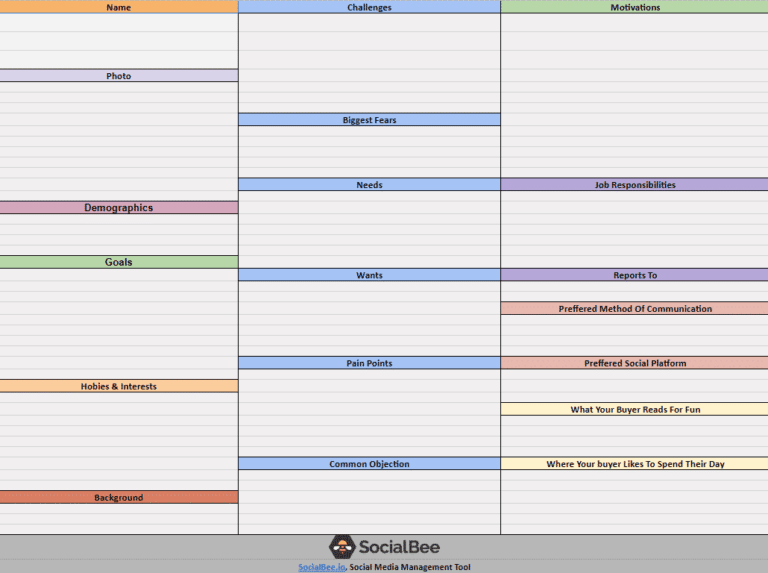
2. Choose the right social media platforms for your business
Choose social media platforms that enable you to achieve your business goals and where your target audience spends the majority of their time.
To determine where your followers are most active and prioritize platforms that offer the most engagement potential for your social media campaigns, conduct thorough market research, use social media analytics, and leverage customer surveys.
Keep in mind that each social media channel serves different purposes; match your goals with the platforms designed to achieve them, and ensure your content aligns with the chosen platforms.
Here are the ideal social channels for small businesses:
- Facebook: Allows businesses to create Facebook pages for business that serve as a mini-website for showcasing services, engaging with customers, and posting updates. You can also do this in Facebook groups.
- Instagram: Ideal for visual storytelling through captivating images and videos, Stories, and Reels.
- X (Twitter): Great for real-time engagement and customer service, hashtag campaigns to increase visibility, and the ability to share quick updates, news, and to participate in trending conversations.
- YouTube: The premier platform for long-form video content, offering businesses an opportunity to create high-performing video content.
- Pinterest: Acts as a discovery platform for high-intent users, with features like shoppable pins and boards that can serve as a catalog of products or ideas, driving high-quality web traffic and keeping users interested.
- LinkedIn: The ‘it’ platform for networking, B2B marketing strategies, and securing thought leadership through articles and posts.
- TikTok: Dominates in short-form video content, providing businesses with the chance to go viral when they create engaging content.
- Google Business Profile: Essential for local SEO, allowing businesses to create a company page and increase their online presence on Google Maps and Google Search.
PRO TIP: Resource availability is very important. Effective social media management demands time for content creation, audience engagement, and social media monitoring. Focus on one or two platforms you can manage successfully, starting small and expanding to multiple social platforms as you grow.
3. Craft a social media strategy that converts
In the current social media landscape, conducting frequent competitive analysis is essential for you to understand their marketing strategy, how they manage multiple social media accounts, what content performs well, and how they engage with their specific audiences. This insight helps to identify opportunities for differentiation and strategies that are proven to engage your target audience.
Here are some things to add to your social media strategy:
- Establish content pillars that help you achieve your goals and plan a diverse content mix.
- Set up a customized posting schedule based on your target audience research.
- Customize your approach for different platforms.
Then, develop a plan that includes a variety of content types (e.g., posts, videos, Stories) tailored to your audience’s preferences and your platforms of choice.
4. Run multiple accounts more easily with social media management tools
For small businesses dipping their toes into social media management, marketing automation is a must for improving your workflow.
Social media management apps offer a powerful way to juggle multiple business social media accounts, schedule posts, interact with your audience, and track performance in a holistic manner.
Begin by determining your requirements from a social media management company. Consider the number of social accounts you’ll manage, the volume of content you’ll publish, and your need for basic analytics or detailed analytics, team collaboration features, and customer engagement tools.
Based on your findings, research and select a social media management software that suits your business goals and budget.
Here are the best social media tools for small businesses to manage content:
- SocialBee is the best social media management tool for small businesses that need an affordable all-in-one solution. It’s an easy-to-use tool that allows you to create content, generate content with AI, schedule and publish posts, reply to messages, and analyze your performance without the need for a social media team.
- NapoleonCat facilitates customer engagement, content publishing, auto-moderation, analytics, and reporting across multiple platforms. This social media management service is particularly useful for companies aiming to increase response rates on social media, organize efficient workflows, and automate and improve customer service and sales processes.
- Later excels as a social media management platform tailored for visual content creators, small businesses, and influencers, particularly those focusing on Instagram and TikTok.
- StoryChief is a comprehensive platform designed to help businesses improve their content creation and distribution processes across multiple accounts. It’s ideal for enhancing SEO, generating leads, and tracking content performance.
- Loomly provides social media marketing tools for visual content calendar management, content creation, and team collaboration. It offers suggestions for post ideas and optimizes posting times, making it suitable for teams looking to improve their social media marketing efficiency and creativity.
Check out this table to see how these platforms compare in terms of key features and functionality:
| Features | SocialBee | NapoleonCat | Later | StoryChief | Loomly |
| Supported Platforms | Facebook, X (Twitter), Instagram, LinkedIn, Pinterest, Google Business Profile, TikTok, YouTube, and Bluesky | Facebook, X (Twitter), Instagram, LinkedIn, Google Business Profile, TikTok, and YouTube | Facebook, X (Twitter), Instagram, LinkedIn, Pinterest, Google Business Profile, and TikTok | Facebook, X (Twitter), Instagram, LinkedIn , Google Business Profile, and TikTok | Facebook, X (Twitter), Instagram, LinkedIn, Pinterest, Google Business Profile, TikTok, Snapchat |
| AI-Powered Content Generation | ✅ | ✅ | ✅ | ✅ | ❌ |
| Content Categories | ✅ | ✅ | ❌ | ✅ | ❌ |
| Content Scheduling | ✅ | ✅ | ✅ | ✅ | ✅ |
| Bulk Scheduling | ✅ | ✅ | ✅ | ✅ | ✅ |
| Evergreen Posting | ✅ | ❌ | ❌ | ✅ | ✅ |
| Social Media Calendar | ✅ | ✅ | ✅ | ✅ | ✅ |
| RSS Feed Import | ✅ | ✅ | ❌ | ❌ | ✅ |
| Hashtag Generator | ✅ | ❌ | ✅ | ❌ | ✅ |
| Visual Integrations (e.g., Canva, Unsplash, GIPHY) | ✅ | ❌ | ✅ | ❌ | ✅ |
| Multiple Shortlink Tools | ✅ | ✅ | ❌ | ❌ | ✅ |
| Social Media Analytics | ✅ | ✅ | ✅ | ✅ | ✅ |
| Export PDF Reports | ✅ | ✅ | ❌ | ✅ | ✅ |
| Team Collaboration | ✅ | ✅ | ❌ | ✅ | ✅ |
| Multiple Workspaces | ✅ | ✅ | ❌ | ✅ | ❌ |
| Social Media Inbox | ✅ | ✅ | ❌ | ❌ | ✅ |
| Free Trial | 14-day free trial | 14-day free trial | 14-day free trial | 7-day free trial | 14-day free trial |
| Starting Price | $29/month | $89/month | $25/month per channel | €29/month per workspace | $42/month |
Once you’ve chosen your social media management software, set up and integrate all your social media accounts into the platform.
5. Keep an eye on social media trends
For small businesses diving into digital marketing, incorporating trends helps you stay relevant and drive engagement.
For instance, a trend that’s gained even more traction since last year was adding meme templates to videos for an added layer of humor. Check out this example from @etfamilytravel:
Here’s how to track and implement social media trends as a small business:
- Regularly schedule time to research industry news and social media reports. This ensures you stay updated without overwhelming your daily tasks.
- Pay attention to influencers and thought leaders in your field on social networks. Their adoption of new trends can offer valuable insights and inspiration.
- Direct interaction with your followers can reveal shifting interests and gather feedback on new trends. Encourage and value their input for firsthand insights.
- Participate in social media groups and industry forums. These platforms are rich sources for discussions on the latest trends and networking.
- Webinars and conferences are great for deep dives into social media trends and offer networking and business opportunities with industry peers.
- Don’t shy away from exploring new platforms or features. Early experimentation can differentiate your brand and attract a forward-thinking audience.
6. Leverage social commerce across your social media accounts
Social commerce can transform your accounts into dynamic sales channels. It’s something you need to master if you’re involved in eCommerce. Each platform provides distinctive features that cater to the diverse aspects of the buyer’s journey, from discovery to purchase.
Here’s how to leverage social commerce across social media efficiently as a small business:
- X (Twitter): While X doesn’t offer direct shopping features, you can use tweets to highlight products, share promotions, and post links to direct followers to your online store.
- YouTube: Include product links in your video descriptions for businesses to direct potential customers to your website or shop.
- Pinterest: Use product Pins to turn your pins into shoppable posts. This enables users to see prices and product availability and proceed to your checkout page.
- LinkedIn: While LinkedIn users don’t have direct selling features, it’s an excellent platform for B2B commerce. Create posts and articles highlighting your products or services to direct traffic to your website.
- TikTok: For eligible businesses, use TikTok’s features to create a shoppable profile or integrate your product catalog, making your content shoppable and appealing to the platform’s younger audience.
- Google Business Profile: Ensure your Google Business Profile is up-to-date, with accurate contact information, business hours, and a link to your website.
- Facebook: Use Facebook Shop to create a customizable digital storefront directly on your page. Ensure your shop is fully stocked with your latest products, complete with high-quality images and detailed descriptions.
- Instagram: Use Instagram’s Shoppable Posts feature to label and tag products in your images and Stories and allow users to purchase straight from the post.
PRO TIP: For an enhanced buying experience, use Instagram Checkout, so users can buy products without leaving the app.
7. Engage your audience and build a community
Engaging your audience and instilling a sense of community and belonging around your brand are pivotal steps toward fostering loyalty and driving growth.
Here’s how small businesses can effectively engage their audience and build a community:
- Listen and respond: Use social media listening to monitor mentions, comments, and direct messages across your platforms. Promptly address any customer inquiries to show your followers that you value them.
- Deliver value: Your content should entertain, educate, or inspire your audience. Use a content mix that includes videos, images, quizzes, and stories to keep your online presence dynamic and engaging.
- Encourage user-generated content: UGC is a marketing tactic that provides you with additional content to share while making your followers a part of your brand’s story.
- Start discussions: Ask questions, create polls, and initiate conversations around subjects relevant to your audience.
- Host live sessions: Leverage the live video format on platforms like Instagram, Facebook, and TikTok to host Q&A sessions, share behind-the-scenes content, or showcase your products.
- Create exclusive groups: Create groups on platforms like Facebook and LinkedIn to create meaningful connections for customers over shared interests, receive exclusive updates, and provide feedback.
- Highlight customer stories: Share customer testimonials, success stories, or how-to guides based on customer experiences to recognize your best customers.
- Run contests and giveaways: Ensure your contests are easy to participate in and offer value to your audience.
- Provide exclusive offers: Provide your most loyal social media followers with discounts, early access to new products, or special content.
- Monitor conversations: Use social listening tools to conduct sentiment analysis and learn what social media users say about your brand. This can help you address negative feedback promptly, identify brand advocates, and spot trends that can inform your content strategy.
With features designed to improve your workflow, SocialBee’s Engage Module allows you to monitor brand mentions, acknowledge customer feedback, and handle requests promptly and professionally across social networking sites.
Say goodbye to the chaos of app-switching, as SocialBee allows you to reply to all your mentions, comments, and DMs from a unified dashboard, saving you time and increasing efficiency for social media interactions.
Reply to all your social media comments, mentions, and DMs from one centralized hub with SocialBee.
8. Track and measure success
For small businesses diving into social media management, tracking and measuring various social media metrics is critical to understanding the impact on your business goals.
Here’s how you can assign measurable KPIs to your business objectives:
Business Objectives | KPIs to Track |
Increase Brand Awareness |
|
Drive Website Traffic |
|
Generate Leads |
|
Boost Sales |
|
Enhance Customer Engagement |
|
Improve Brand Loyalty |
|
PRO TIP #1: Develop regular reporting schedules (monthly, quarterly) to compile and review your social media content performance data. Use your findings to refine content, adjust posting schedules, target your audience more effectively, and enhance user engagement.
The easiest way to monitor your entire social media strategy is by using SocialBee. Keep an eye on important metrics like growth and engagement for all your platforms in one place, and easily share your analytics in seconds by downloading them as a PDF.
Get a social media management platform like SocialBee to access real-time analytics and make informed decisions.
PRO TIP #2: Use UTM (Urchin Tracking Module) parameters to add relevant tags to any website URL shared on your social media channels. This allows you to track specific campaigns, giving you insight into how social media traffic behaves on your website and contributes to conversions.
PRO TIP #3: Beyond engagement, assess how well social media efforts drive actions that have direct business value, such as actual sales, sign-ups, or inquiries. Use conversion tracking tools to measure these activities.
Frequently asked questions
When it comes to the best social media management tool for small businesses, SocialBee stands out as an all-in-one platform. SocialBee offers a comprehensive suite of features, including real-time analytics, content scheduling, audience engagement tools, and more.
Its user-friendly interface and ample functionality make it ideal for small businesses and enterprise companies alike looking to improve their social media efforts and achieve tangible results on various social media networks.
Social media account managers have responsibilities that include developing a content strategy that matches the business’s goals and engages the audience, creating and scheduling diverse content like posts and videos, and actively engaging with customers on social platforms.
They also track and analyze social media performance, making adjustments to the strategy based on data-driven insights. Additionally, they stay updated on the latest social media trends and platform changes to keep the business’s social media marketing relevant and effective.
Starting social media management involves defining specific goals (like increasing brand awareness), understanding your target audience, and choosing appropriate platforms.
Key steps include creating and scheduling engaging content, interacting with your audience, monitoring performance using analytics tools, and adjusting strategies based on these insights.
It’s important to maintain professional engagement, stay updated with social media trends, and adhere to platform policies and ethical standards. You can do all this yourself or by employing a social media agency or using a management tool.
Upgrade the social media presence of your business with SocialBee!
In conclusion, navigating the realm of social media management for small businesses requires a delicate balance of strategy, creativity, and adaptability.
Remember, success in social media management is all about being strategic and intentional with your efforts. Regularly monitor your performance metrics, experiment with new approaches, and always stay open to learning and evolving.
If you want to take your social media management to the next level, give SocialBee a try. With its suite of powerful features and user-friendly interface, SocialBee empowers small businesses to streamline their social media efforts and achieve remarkable results.
Start your SocialBee 14-day free trial to create a strong social media presence for your business!
